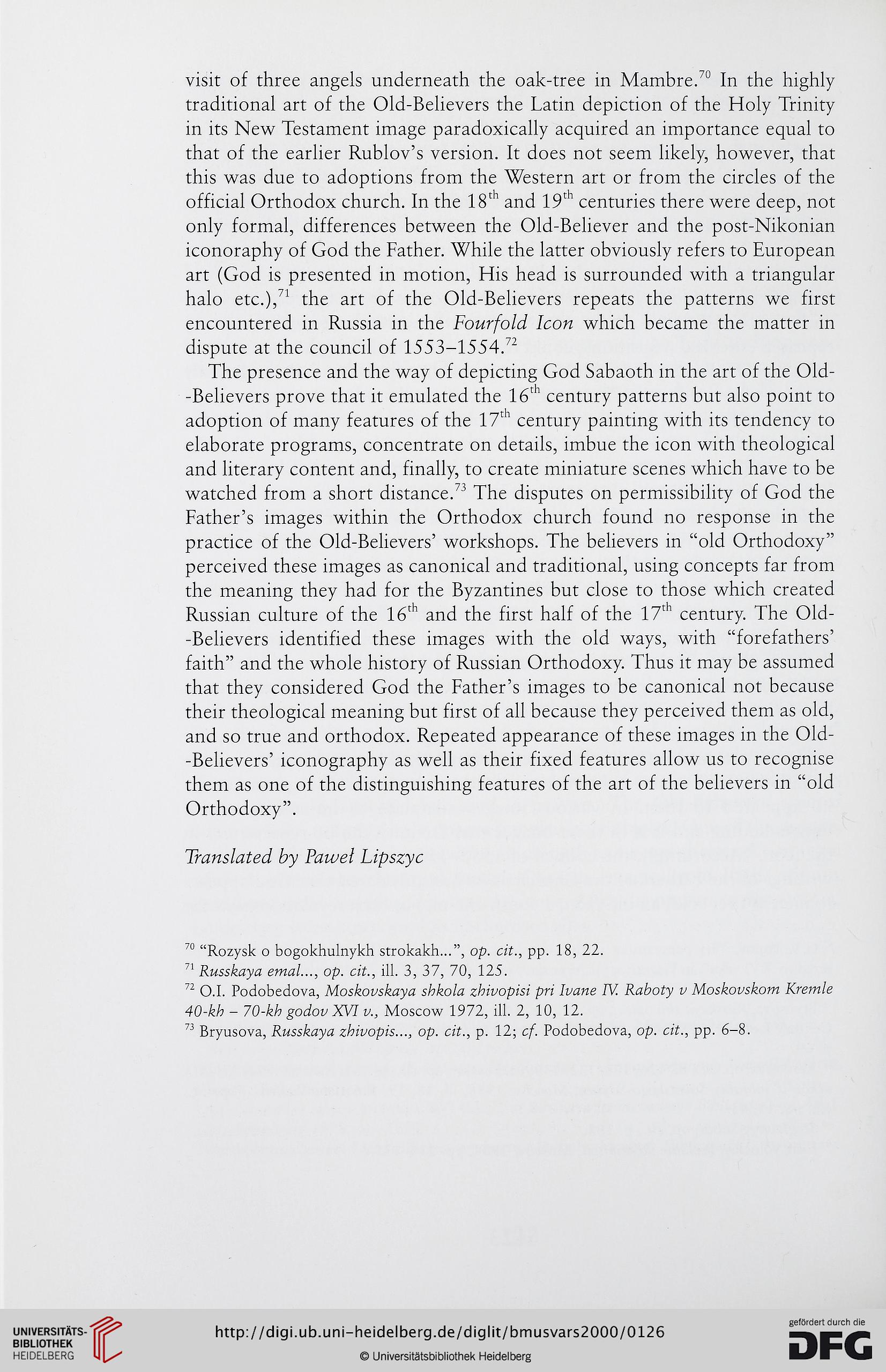visit of three angels underneath the oak-tree in Mambre.70 In the highly
traditional art of the 01d-Believers the Latin depiction of the Holy Trinity
in its New Testament image paradoxically acąuired an importance eąual to
that of the earlier Rublov’s version. It does not seem likely, however, that
this was due to adoptions from the Western art or from the circles of the
official Orthodox church. In the 18rh and 19rh centuries there were deep, not
only formal, differences between the 01d-Believer and the post-Nikonian
iconoraphy of God the Father. While the latter obviously refers to European
art (God is presented in motion, His head is surrounded with a triangular
halo etc.), 1 the art of the Old-Believers repeats the patterns we first
encountered in Russia in the Fourfold Icon which became the matter in
dispute at the council of 1553-1554.72 73
The presence and the way of depicting God Sabaoth in the art of the Old-
-Believers prove that it emulated the 16th century patterns but also point to
adoption of many features of the 17th century painting with its tendency to
elaborate programs, concentrate on details, imbue the icon with theological
and literary content and, finally, to create miniaturę scenes which have to be
watched from a short distance. 3 The disputes on permissibility of God the
Father’s images within the Orthodox church found no response in the
practice of the 01d-Believers’ workshops. The believers in “old Orthodoxy”
perceived these images as canonical and traditional, using concepts far from
the meaning they had for the Byzantines but close to those which created
Russian culture of the 16th and the first half of the 17th century. The Old-
-Believers identified these images with the old ways, with “forefathers’
faith” and the whole history of Russian Orthodoxy. Thus it may be assumed
that they considered God the Father’s images to be canonical not because
their theological meaning but first of all because they perceived them as old,
and so true and orthodox. Repeated appearance of these images in the Old-
-Believers’ iconography as well as their fixed features allow us to recognise
them as one of the distinguishing features of the art of the believers in “old
Orthodoxy”.
Translated by Paweł Lipszyc
70 “Rozysk o bogokhulnykh strokakh...”, op. cit., pp. 18, 22.
1 Russkaya emal..., op. cit., ill. 3, 37, 70, 125.
72 O.I. Podobedova, Moskovskaya sbkola zhivopisi pri lvane IV. Raboty v Moskovskom Kremle
40-kh - 70-kb godov XVI v., Moscow 1972, ill. 2, 10, 12.
73 Bryusova, Russkaya zhivopis..., op. cit., p. 12; cf. Podobedova, op. cit., pp. 6-8.
traditional art of the 01d-Believers the Latin depiction of the Holy Trinity
in its New Testament image paradoxically acąuired an importance eąual to
that of the earlier Rublov’s version. It does not seem likely, however, that
this was due to adoptions from the Western art or from the circles of the
official Orthodox church. In the 18rh and 19rh centuries there were deep, not
only formal, differences between the 01d-Believer and the post-Nikonian
iconoraphy of God the Father. While the latter obviously refers to European
art (God is presented in motion, His head is surrounded with a triangular
halo etc.), 1 the art of the Old-Believers repeats the patterns we first
encountered in Russia in the Fourfold Icon which became the matter in
dispute at the council of 1553-1554.72 73
The presence and the way of depicting God Sabaoth in the art of the Old-
-Believers prove that it emulated the 16th century patterns but also point to
adoption of many features of the 17th century painting with its tendency to
elaborate programs, concentrate on details, imbue the icon with theological
and literary content and, finally, to create miniaturę scenes which have to be
watched from a short distance. 3 The disputes on permissibility of God the
Father’s images within the Orthodox church found no response in the
practice of the 01d-Believers’ workshops. The believers in “old Orthodoxy”
perceived these images as canonical and traditional, using concepts far from
the meaning they had for the Byzantines but close to those which created
Russian culture of the 16th and the first half of the 17th century. The Old-
-Believers identified these images with the old ways, with “forefathers’
faith” and the whole history of Russian Orthodoxy. Thus it may be assumed
that they considered God the Father’s images to be canonical not because
their theological meaning but first of all because they perceived them as old,
and so true and orthodox. Repeated appearance of these images in the Old-
-Believers’ iconography as well as their fixed features allow us to recognise
them as one of the distinguishing features of the art of the believers in “old
Orthodoxy”.
Translated by Paweł Lipszyc
70 “Rozysk o bogokhulnykh strokakh...”, op. cit., pp. 18, 22.
1 Russkaya emal..., op. cit., ill. 3, 37, 70, 125.
72 O.I. Podobedova, Moskovskaya sbkola zhivopisi pri lvane IV. Raboty v Moskovskom Kremle
40-kh - 70-kb godov XVI v., Moscow 1972, ill. 2, 10, 12.
73 Bryusova, Russkaya zhivopis..., op. cit., p. 12; cf. Podobedova, op. cit., pp. 6-8.





